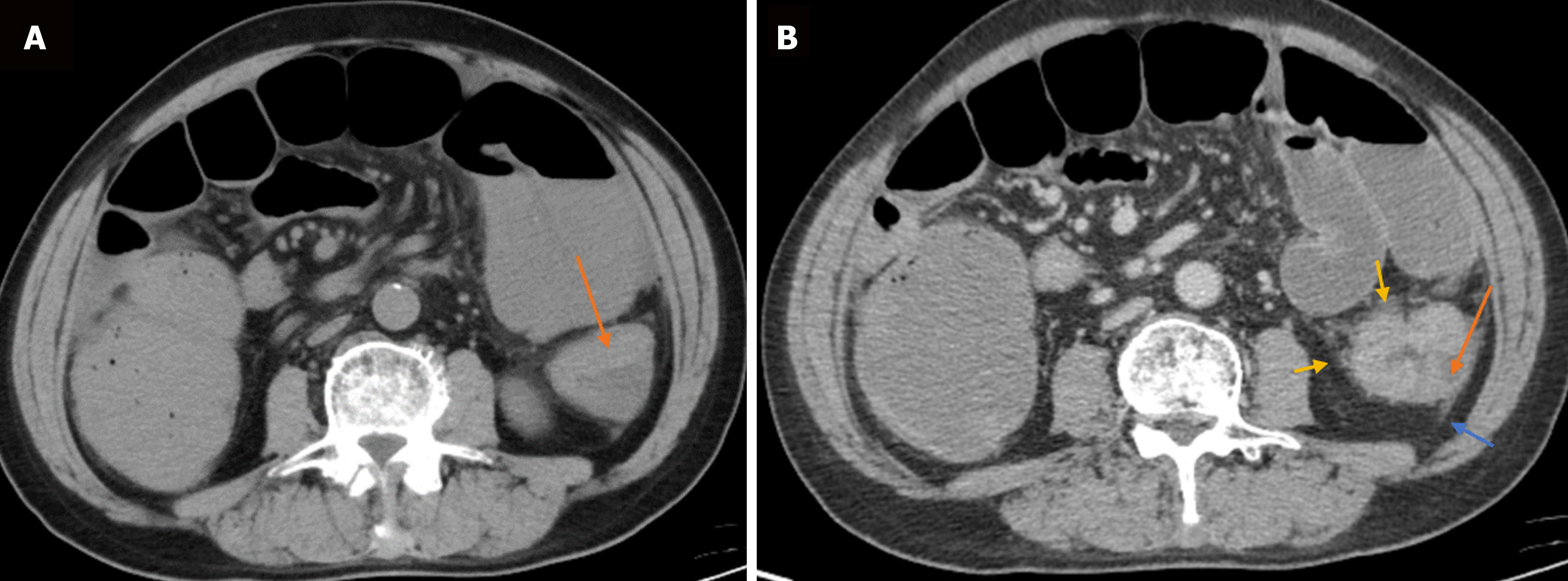Copyright
©The Author(s) 2024.
World J Gastrointest Surg. Jul 27, 2024; 16(7): 2145-2156
Published online Jul 27, 2024. doi: 10.4240/wjgs.v16.i7.2145
Published online Jul 27, 2024. doi: 10.4240/wjgs.v16.i7.2145
Figure 1 Computed tomography image of a 44-year-old male patient with colorectal cancer.
A: Plain computed tomography (CT) scan. The wall of the left descending colon (lower pole region of the flat kidney) was thickened circularly, and a soft tissue mass (indicated by the orange arrow) was observed. The density of the mass was similar to that of the muscle. The CT value was approximately 48 HU; B: Enhanced CT. The density of the mass was higher than that of the muscle, the CT value was approximately 68 HU, a weak enhancement area was seen in the mass (indicated by the orange arrow), the fat layer around the mass was blurred with enhancement (indicated by the yellow arrow), and the lateral vertebral fascia was thickened and enhanced (indicated by the blue arrow). The images also show that the patient’s proximal bowel duct was dilated.
Figure 2 Computed tomography image of a 63-year-old female patient with colorectal cancer.
A: Plain computed tomography (CT) scan. The wall of the upper rectum was eccentrically thickened, and the CT value of the soft tissue mass was approximately 42 HU; B: Enhanced CT. The blurring of fat in the mesorectum and enhancement of the cord (indicated by the orange arrow) closest to the rectal fascia were approximately 5 mm away (indicated by the yellow arrow).
Figure 3 Receiver operating characteristic curve analysis for sensitivity and specificity.
BMI: Body mass index; CT: Computed tomography.
Figure 4 Kaplan-Meier curve.
A: Degree of periintestinal infiltration; B: Tumor size; C: Lymph node computed tomography value; D: Body mass index. BMI: Body mass index; CT: Computed tomography.
Figure 5 Scatter plot of correlation between postoperative survival time and abdominal computed tomography signs in patients with colorectal cancer.
A: Degree of periintestinal infiltration; B: Tumor size; C: Lymph node computed tomography value; D: Mean tumor long-axis diameter; E: Mean tumor short-axis diameter; F: Body mass index. BMI: Body mass index; CT: Computed tomography.
- Citation: Yang SM, Liu JM, Wen RP, Qian YD, He JB, Sun JS. Correlation between abdominal computed tomography signs and postoperative prognosis for patients with colorectal cancer. World J Gastrointest Surg 2024; 16(7): 2145-2156
- URL: https://www.wjgnet.com/1948-9366/full/v16/i7/2145.htm
- DOI: https://dx.doi.org/10.4240/wjgs.v16.i7.2145













